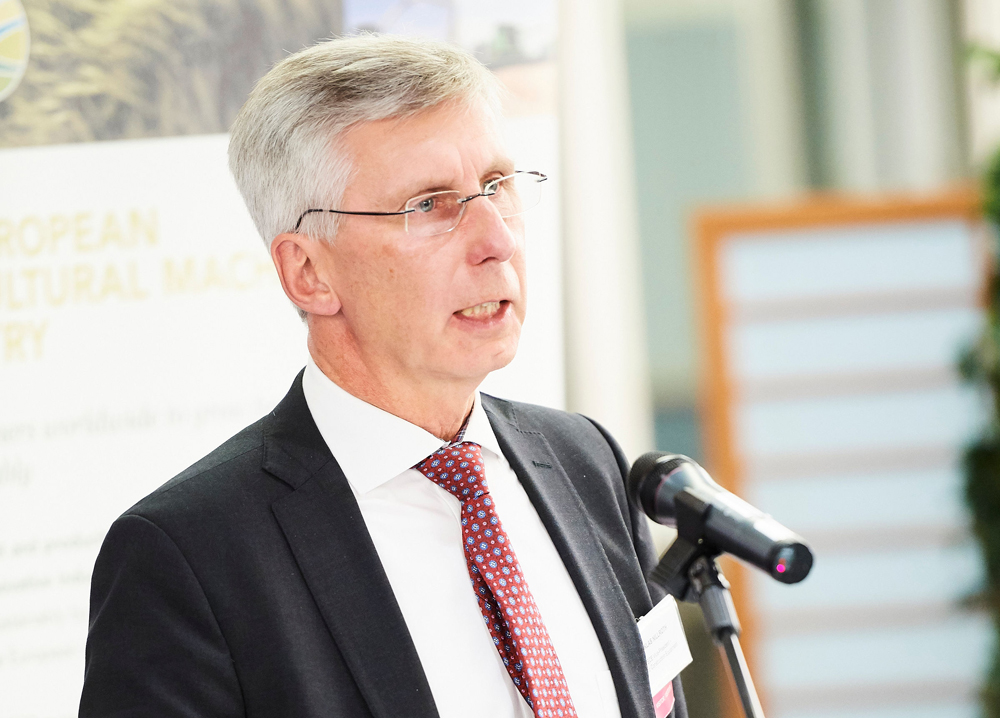
Niklas Nillroth has certainly faced some challenges in the first 12 months of his two-year term as president of European construction equipment manufacturers association CECE.
The most conspicuous of these was the impact of Covid-19 – the 56-year-old Swede took over his new role in January 2020, just as the global pandemic was gathering speed.
He is an enthusiastic champion of the European construction sector's vital role in helping the region recover from the economic impact of Covid. The EU's European Recovery Plan is making available €750bn of fresh finance at a national level across the region for economies to kickstart investment and growth, and CECE (Committee for European Construction Equipment) is monitoring the progress of the plans and how they affect its 1,200 manufacturing members.
"We are trying to coordinate the views of our members to make sure that construction and infrastructure receive the needed attention at the EU and national level," says Nillroth. "This is not because we want the resources of the recovery fund to go towards our industry for the sake of it, but because we know the multiplier effect at local level that the construction industry has on growth, prosperity and employment."
As part of these efforts, on December 2 CECE hosted an event of the Construction 2050 Alliance that gathered representatives from ministries in four EU countries to exchange and share best practices on how nations such as France and Germany are setting up national recovery plans that prioritise construction. The alliance, unveiled in June this year, is a group of 46 European organisations working together to advance the needs and priorities of the wider construction and built-environment sector at EU level.

Beyond Covid, there are other issues that Nillroth attaches equal importance to addressing during his term as CECE president. Foremost among these is sustainability – indeed his 'day job' at Volvo Construction Equipment is as vice president of sustainability and public affairs. He has worked for the Swedish manufacturer for over 20 years in a number of different management positions and says this experience is a great asset in his current role at Volvo CE.
"To head up the sustainability function is a matter of understanding the company's current business environment, organisation, complete product offering, industrial system and, together with all internal and external key stakeholders, drive change in a strategically sustainable direction," Nillroth says.
Although his CECE role is much broader than just sustainability in construction, Nillroth says the topic is a major focus, and he is giving special attention to the push for emission reduction and the initiatives being put in place by authorities and the rest of the industry.
"This is the key megatrend for CECE, most of all concerning the positive impact that newly introduced machines can have in fighting pollution and improving air quality," he adds. "What is still missing – and I want to focus on – are the pull factors making these technologies appealing and mainstream for clients and users in the larger construction industry."
He adds that sustainability is one of the main drivers for change in European society, with the recently published European Green Deal's aim of making Europe climate neutral by 2050 an example of this.
He says there is no single solution for the construction equipment on this issue, and it needs to develop multiple driveline technologies while collaborating with key stakeholders in areas such as sustainable biofuels and increased electric grid capacity.
"With the broader definition of sustainability in mind, I would like to highlight all the great achievements our industry has contributed with, for example. improved safety at construction worksites," he says. "With new technology available, such as autonomous machines and artificial intelligence, I am sure we will see many innovations in the years to come."
He believes that the construction sector must take a holistic view of the sustainability issue, meaning that there is a focus on all its dimensions: economic, environmental and social. To be able to do good in the two latter areas, Nillroth says the industry needs to be wealthy and successful on the global market. He adds that the most important environmental challenge in the years to come will be to contribute to the global combat of climate change by reducing the CO2 emissions.
"The holistic approach also means that all parts of the construction value chain are included in our sustainability approach," he says. This issue is highlighted in a documentary on sustainable construction available on CECE's YouTube channel.
Another area in which he has engaged personally for a considerable time is the importance of attracting the next generation employees to the construction equipment industry, specifically the key talents that are needed for the future. This issue was also highlighted by CECE secretary general Riccardo Viaggi at the annual CECE Congress in October, which this year was held virtually for the first time and broadcast from Stockholm. Viaggi said the ageing population in some EU countries is "a societal challenge" for construction companies, 60% of which are SMEs and many of these being owned by people nearing retirement age with no succession plans in place.
"The global megatrends and transformative changes we are now facing require new skills and competences in our member companies," Nillroth states. "Studies show that many of these new colleagues have clear expectations from their employers, such as the balance between work and free time, flexibility, ability to influence and, not least, a clear commitment to sustainability."
The construction equipment sector is still often portrayed as 'dirty and dusty', archaic and not meant for the young generation, but Nillroth says this could not be further from the truth and that one of CECE's objectives is to improve the overall image of the industry. "The competence shift, related to the new technologies requires attracting young, skilled workforce to the industry," he adds.
Looking back on what he and his team at CECE have achieved during his first year in office, Nillroth highlights their role in the united NRMM (non-road mobile machinery) industry push for the extension of transition deadlines in the EU's Stage V Regulation for off-road engine emissions. The 12-month extension of certain transitional provisions in Stage V became EU law and applicable retroactively from 1 July 2020.
"This fundamental political success allows machinery manufacturers to avoid economic damage and unnecessary waste of raw materials and resources since the transition engines were already built in 2018 and would otherwise have to be scrapped," he says.
In terms of his future goals at CECE, Nillroth says he is continuing the long-term strategy of his predecessors in embracing the transition into the digital era. He hopes to be instrumental in bringing CECE's DigiPLACE project to achieve digitalisation in the industry to a successful conclusion in May 2021, and for that to lead on to the rollout of digital industrial platforms across the construction sector.
Digitalisation is one of the great enablers for increased productivity in the construction equipment sector, according to Nillroth, and he adds that there is initially a need to raise awareness in the industry.
"To seize the digitalisation opportunity, the CE industry needs to understand and act on our customers' needs and to offer products and services accordingly," he says. "It is also clear that international standardisation is needed to fully capture the improvement potentials."

Another specific contribution Nillroth would like to make during his CECE presidency is in improving the public perception of the construction equipment industry with the EU in Brussels. This includes its role as a solution provider for the most pressing societal challenges, from climate adaptation to demographic changes, from workers' safety to overall contribution of construction to society.
"This is why I place a lot of attention on the Construction 2050 Alliance, of which the European Aggregates Association UEPG is also a founding member," he adds.
Industry regulation is another focus for Nillroth in his work at CECE. Three key pieces of legislation are being proposed by the European Commission during 2020-2021 – the Machinery Directive, the Outdoor Noise Directive and the Road-Circulation framework for off-highway machines. He says that several groups of dedicated CECE experts are actively collecting and sharing their knowledge to contribute to an informed decision-making process at the EU level.
In addition to these construction equipment-specific legislations, the launch of the so-called SCIP database, generally addressing the use of materials containing hazardous substances in the EU, is coming up soon and its potential requirements are an area of concern for CECE members.
"From a CECE point-of-view, we support the goal to substitute hazardous materials in our products," says Nillroth. "The set-up of the database by the EU ECHA authority might, however, create additional administration and we are, together with several other industry associations, trying to propose alternative and improved solutions."
This year has certainly been a difficult one for the European construction equipment industry. Recent market estimates by Off-Highway Research predict a downturn in every region of the globe except China. Overall sales globally should decrease by over 15%, but certain areas of Europe will perform slightly better (Germany and Scandinavia), whereas machinery sales in China will actually increase compared to 2019.
"What we all look for is the rebound in 2021, and that still depends too much on the evolution of the pandemic and the public spending support by recovery plans in the most important regions of the world," says Nillroth.
In terms of impact on different types of equipment types, Nillroth says that, while it is premature to make forecasts, there is consensus in the industry that a slowdown of real-estate projects will mean reduced demand for compact machinery and concrete equipment, whereas road-building and heavy machinery is expected to be dragged upwards by public spending on infrastructure projects.
Given his focus on the sustainability issue, it seems appropriate that in his interests away from construction equipment Nillroth enjoys a healthy outdoor lifestyle. Married to wife Cecilia, he has two daughters Sara and Lina who have both left the family nest.
"I have always been interested in sports, and I am trying to practice some running and tennis on a regular basis," he says. "Like most Swedes, I like life close to nature, especially in the summertime when my family and I stay at our weekend house at Öland, an island on the Baltic Sea. Renovating the house and practising some windsurfing are favourite activities to recharge for heavy periods of work!"








